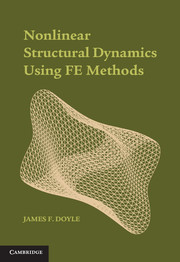Book contents
2 - Dynamics of Discretized Systems
from PART I - MECHANICS AND MODELS
Published online by Cambridge University Press: 05 October 2014
Summary
As presented in terms of Newton's laws of motion, our notion of (dynamic) equilibrium is that “the sum of the forces is equal to mass times acceleration” applied to a free-body diagram. This does not generalize well to large, complex systems (with many DoFs), particularly if they are nonlinear. The concepts of virtual work and virtual energy allow us to present a formulation for the equilibrium of discrete systems that does not entail the use of summing forces on free-body diagrams. This formulation, usually referred to as analytical mechanics, generalizes very nicely for the many-body systems we wish to explore. It is quite versatile because it is applicable to nonlinear, nonconservative, and dynamic problems alike and is very suitable for numerical implementation. Furthermore, our complex systems, by necessity, involve approximations in the structural modeling, and our formulation is quite compatible with this necessity.
We first develop the principle of virtual work and then, through D'Alembert's principle, apply it to dynamic systems. The resulting governing equations are general enough to handle nonlinear systems. The different types of nonlinear contributions are then clarified. The work and energy ideas of this chapter are covered extensively in references 52, 54 and 90, and the style of presentation follows reference 30.
Principle of Virtual Work
Our idea of a structure is an object with multiple parts. We use the multimember structure of Figure 2.1 to illustrate some of the basic concepts in structural mechanics.
- Type
- Chapter
- Information
- Nonlinear Structural Dynamics Using FE Methods , pp. 54 - 91Publisher: Cambridge University PressPrint publication year: 2014



